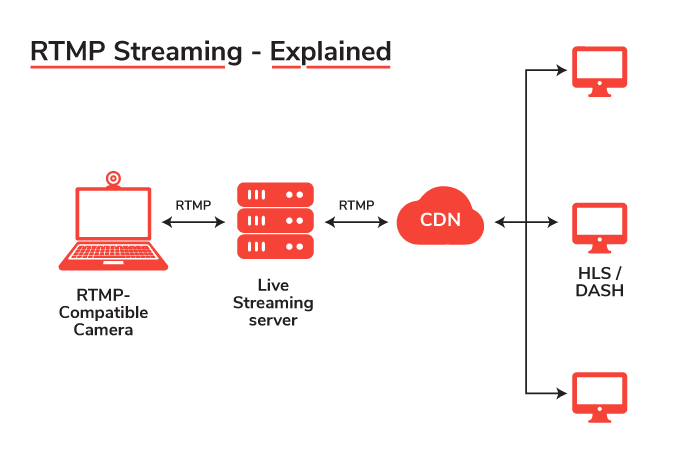
Introduction
In the realm of live streaming, Twitch stands out as one of the most popular platforms, allowing users to broadcast their gaming sessions and connect with a vast audience. Behind the scenes, Twitch relies on a technology called RTMP (Real-Time Messaging Protocol) to enable seamless streaming. In this article, we will delve into the workings of the Twitch RTMP server, exploring its importance, functionality, and impact on the live streaming experience.
Table of Contents
- What is RTMP?
- The Role of the Twitch RTMP Server
- How Does the Twitch RTMP Server Work?
- Key Features of the Twitch RTMP Server
- Low Latency
- Adaptive Bitrate
- Scalability
- Setting Up a Twitch RTMP Server
- Troubleshooting Common RTMP Server Issues
- The Future of RTMP in Live Streaming
- Conclusion
- FAQs (Frequently Asked Questions)
1. What is RTMP?
RTMP, or Real-Time Messaging Protocol, is a widely used streaming protocol that enables the transmission of audio, video, and data in real-time over the internet. It was developed by Adobe Systems and has become a standard in the live streaming industry due to its low latency and compatibility with various devices and platforms.
2. The Role of the Twitch RTMP Server
The Twitch RTMP server serves as the backbone of the Twitch streaming platform. It acts as an intermediary between the broadcaster’s streaming software and the viewers, facilitating the transmission of live streams from the source to the Twitch servers, and subsequently to the viewers’ devices.
3. How Does the Twitch RTMP Server Work?
When a broadcaster starts streaming on Twitch, their streaming software establishes a connection with the Twitch RTMP server. The server then receives the incoming video and audio data and distributes it to the viewers who are tuned into the stream. This process involves a series of steps, including video encoding, transcoding, and delivery optimization to ensure smooth playback across a wide range of devices and network conditions.
4. Key Features of the Twitch RTMP Server
a. Low Latency
One of the primary advantages of the Twitch RTMP server is its low latency. Latency refers to the delay between the broadcaster’s actions and the viewers’ perception of those actions. The Twitch RTMP server employs optimization techniques to minimize this delay, providing a near-real-time streaming experience for the viewers.
b. Adaptive Bitrate
The Twitch RTMP server also incorporates adaptive bitrate streaming, which adjusts the quality of the video stream based on the viewers’ internet connection speed. This ensures that viewers with varying network conditions can still enjoy a smooth streaming experience without buffering or interruptions.
c. Scalability
As Twitch attracts millions of viewers and broadcasters, the RTMP server is designed to handle a massive scale of concurrent connections. This scalability allows Twitch to accommodate the high demand for live streaming and maintain a robust infrastructure that can support a vast audience.
5. Setting Up a Twitch RTMP Server
Setting up your own Twitch RTMP server can be a complex task that requires technical expertise. It involves configuring server software, ensuring adequate hardware resources, and optimizing network settings. However, for most broadcasters, using the Twitch platform’s built-in RTMP server is the simplest and most reliable option.
6. Troubleshooting Common RTMP Server Issues
While the Twitch RTMP server generally offers a seamless streaming experience, occasional issues may arise. Some common problems include connection failures, encoding errors, or audio/video synchronization issues. Troubleshooting these problems often involves checking the configuration settings, updating the streaming software, or adjusting the network setup.
7. The Future of RTMP in Live Streaming
As technology evolves, new streaming protocols and technologies emerge. While RTMP has been widely adopted for live streaming, newer protocols such as WebRTC and MPEG-DASH are gaining traction. These protocols offer advantages in terms of lower latency and improved browser compatibility. However, due to the widespread use and familiarity of RTMP, it is likely to remain a prominent streaming protocol for the foreseeable future.
Conclusion
The Twitch RTMP server plays a crucial role in enabling seamless live streaming on the Twitch platform. With its low latency, adaptive bitrate, and scalability, it ensures a high-quality streaming experience for both broadcasters and viewers. As live streaming continues to grow in popularity, understanding the inner workings of the Twitch RTMP server becomes essential for anyone looking to dive into the world of live streaming.
FAQs (Frequently Asked Questions)
Can I use any streaming software with the Twitch RTMP server? Yes, the Twitch RTMP server is compatible with a wide range of streaming software, including OBS, Streamlabs, and XSplit.
Do I need a powerful computer to stream to the Twitch RTMP server? While a capable computer is recommended for optimal streaming performance, the Twitch RTMP server can accommodate various hardware specifications.
Can I stream non-gaming content using the Twitch RTMP server? Twitch initially gained popularity as a gaming platform, but it has since expanded to include non-gaming categories such as art, music, and talk shows. You can stream a variety of content using the Twitch RTMP server.
Are there any fees associated with using the Twitch RTMP server? Twitch provides its streaming platform free of charge, including the use of the RTMP server. However, there may be additional costs or subscription plans for certain features or premium services.
Is the Twitch RTMP server available worldwide? Yes, the Twitch platform and its RTMP server are accessible globally, allowing users from around the world to broadcast and view streams.
Get Access Now: https://www.mslivecdn.com/
